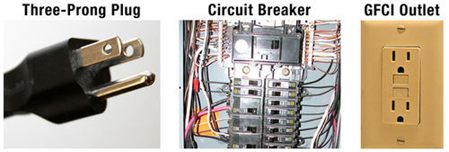Electric Hazards and Safety
Electric hazards and safety
Electricity is dangerous and contact with electric current can cause severe burns and even death. Electricity can also cause serious fires.
Q: A common cause of electric hazards and fires is a short circuit. Do you know what a short circuit is?
A: As its name suggests, a short circuit is damage that allows electric current to travel through a shorter loop than it should. To find out how this can occur and why it is dangerous, keep reading.
How a Short Circuit Occurs
Did you ever see an old appliance with a damaged cord, like the old shown in the Figure below? A damaged electric cord can cause a severe shock if it allows current to pass from the cord to a person who touches it. A damaged cord can also cause a short circuit. A short circuit occurs when electric current follows a shorter path than the intended loop of the circuit. An electric cord contains two wires: one that carries current from the outlet to the appliance and one that carries current from the appliance back to the outlet. If the two wires in a damaged cord come into contact with each other, current flows from one wire to the other and bypasses the appliance. This may cause the wires to overheat and start a fire.

Electric Safety Features
Because electricity can be so dangerous, safety features are built into modern electric circuits and devices. They include three-prong plugs, circuit breakers, and GFCI outlets. You can read about these three safety features in the Figure below.

Three-Prong Plug is used on metal appliances. The two flat prongs carry current to and from the appliances. The round prong is for safety. It connects with a wire inside the outlet that goes down into the ground. If any stray current leaks from the circuit or if there is a short circuit, the ground wire carries the current into the ground, which harmlessly absorbs it.
Circuit Breaker: This electrical panel contains several circuit breakers. A circuit breaker is a switch that automatically interrupts a circuit if too much current flows through it. This could happen if too many electric devices are plugged into the circuit or if too many electric devices are plugged into the circuit or if there is an electric short. Once the problem is resolved, the circuit breaker can be switched back on to complete the circuit so current can flow through it again.
GFCI Outlet: GFCI stands for ground-fault circuit interrupter. GFCI outlets are typically found in bathrooms and kitchens where the use of water poses a risk of shock (because water is a good electric conductor). A GFCI outlet contains a device that monitors the amount of current leaving and returning to the outlet. If less current is returning than leaving, this means that current is escaping. When this occurs, a tiny circuit breaker in the outlet interrupts the circuit. The breaker can be reset by pushing a button on the outlet cover.
Q: Can you think of any other electric safety features?
A: One safety feature is the label on a lamp that warns the user of the maximum safe wattage for light bulbs. Another safety feature is double insulation on many electric devices. Not only are the electric wires insulated with a coating of plastic but so is the entire device. The old toaster pictured in the Figure above lacks this safety feature, but most modern toasters have a plastic casing. This reduces the risk of current leaving the device except through the cord.
Using Electricity Safely
Even with electric safety features, electricity is still dangerous if it is misused. Follow the safety rules below to reduce the risk of injury or fire from electricity.
- Never mix electricity and water. Don’t plug in or turn on electric lights or appliances when your hands are wet, you are standing in water, or you are in the shower or bathtub. The current could flow through the water—and you—because water is a good conductor of electricity.
- Never overload circuits. Avoid plugging too many devices into one outlet or extension cord. The more devices that are plugged in, the more current the circuit carries. Too much current can overheat a circuit and start a fire.
- Never use devices with damaged cords or plugs. They can cause shocks, shorts, and fires.
- Never put anything except plugs into electric outlets. Putting any other object into an outlet is likely to cause a serious shock that could be fatal.
- Never go near fallen electric lines. They could have very high voltage. Report fallen lines to the electric company as soon as possible.
Summary
- A short circuit occurs when electric current follows a shorter path than the intended loop of the circuit. A short circuit may cause wires to overheat and start a fire.
- Several safety features are built into modern electric circuits and devices. They include three-prong plugs, circuit breakers, and GFCI outlets.
- Following safety rules can reduce the risk of injury or fire from electricity.
Review
- What causes a short circuit? Why is a short circuit dangerous?
- Identify an electric safety feature and explain how it works.
- Create an illustrated poster to share electric safety rules with other people your age. Include at least three safety rules in your poster.